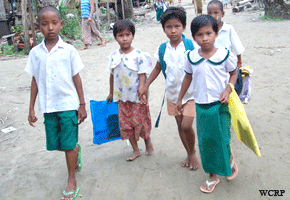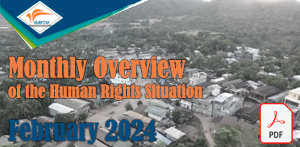Where Is My School, Where Are My Friends?
August 21, 2008
By WCRP:
 A tragic story from one of the Cyclone Nargis hit zones
A tragic story from one of the Cyclone Nargis hit zones
An 11 year old boy, Maung Thein Naing (not his real name), was surprised to hear his father say he had to leave for school in early June, following orders from the village headmen. Soon after Cyclone Nargis ripped through his village and killed his mother and sister, he forgot he was a student. His school in the north of the village near the rice fields also disappeared in the storms of early May.
U Soe Thein (not his real name), the father of Maung Thein Naing, does not want to think about the past and his family. On the 2nd of May Cyclone Nargis combined with about 5 meters of fast moving high tides sweet his wife and 7 year old daughter away; to this day he does not know how they died. He does not want to think about that tragic moment.
Maung Thein Naing remembered that his mother was making food in the morning for him and his sister. After they ate some breakfast, he took the hand of his sister and they went to school together. His sister was in Kindergarten class and he was in 3rd Grade (or 3rd Standard) in the primary level of his village school which was called, ‘Kyin-kaw Primary School’. This school provided 100 students from Kyin-kaw village and the villagers were proud for this small school as they did not have to send their children to other villages. But when the students completed the primary school, they had to attend middle (secondary) school in other villages by passing rice fields.
The school was built with wooden floors and walls, and had a thatched roof. Every thing from this school was blown away by the 150 miles per hour winds. No piece of the school remained.
“I should not have let my wife and my daughter die like this. I don’t want them to be gone. I am quite sorrowful as I could not save their life,” U Soe Thein cries hard as he explains how his wife and daughter died, while his son sits weeping besides him. At the time Cyclone Nargis hit this fishing village killing half his family, he was away from home. He returned home to find only his son, desperately clinging to a tree.
Maung Thein Naing visited the site of his destroyed school and found pieces of the walls, floor and roof littering the ground in the area, while the former playground area was filled with waste and garbage. When he saw the destruction he sat and cried silently for a long time.
“I missed my mom and my sister. I don’t want to go to school. Where is my school? No. no. I don’t want to go to school without my sister,” said Maung Thein Naing.
The education authorities from Ngaputaw Township, Bassein (Pathein) District, Irrawaddy Division, ordered the local village headmen and any surviving school teachers to re-construct schools and accept students. The order stated that all schools must be operational in the first week of June, which is the beginning of the school term in Burma.
After Cyclone Nargis hit, many schools were destroyed, aside from a few located far from the sea and southwestern part of Burma. Thousands of school-age children died and some of the local teachers, especially female teachers, who lived in the villages near the Sea were hit by the Cyclone and died.
The Cyclone caused great disturbance across the region, greatly unsettling the lives of survivors, distracted at the widespread destruction, devastation and the loss of loved ones. Most survivors had to re-construct temporary shelters for their remaining family members. They have to seek food for daily meals by fishing and digging through muddy swamps.
The local government authorities never cared for the victims’ feelings and pains. The local community people, village heads, teachers and students have been suffering from serial forcible instructions by authorities. They were forced to cast votes on the 24th of May for the Constitutional Referendum ballot before being forced to construct schools and find teachers to operate the schools, all the while dealing with their great losses.
“Everyday the people had to think about how to gain rice and food. They were still missing their dead families and crying. The authorities have failed to assist the people (cyclone victims), but they have been successful in practicing how to give orders,” said U Tun Oo (not his real name), a village head from Chaung-wa village.
Because of the orders, Kyin-kaw village heads and their villagers had to build a new school. They could not build in the same location of old school as they could not clear up all garbage and the former school grounds are still flooded. Thus, they decided to build a temporary school in the new location of a nearby rice field.
Now, the village has only one teacher and she accepted the students in the rice field with a make-shift table. But she noticed that the number of students significantly decreased from 97 last academic year to 36 in this academic year. The teacher exactly knew what happened to her students. They will never come back to school again.
“I am missing friends. When I met my teacher, I knew that many of my friends disappeared. I don’t know where they are? Who took them?” said a 9 year old school girl, Ma Thein Da Oo.
Burmese military authorities never recognized the psychological pain of these children and did not set up any plan for a rehabilitation program to somehow relieve the mental anguish of Nargis’ kids. Although the community and teachers believed it was not an appropriate time to open schools in early June, just one-month after the cyclone hit but they could not refuse the orders of the military dictators who rule Burma.
“Nobody came and are comforted us. Only the Abbot in the monastery stressed about Buddha’s teaching of life cycle. The Abbot told a truth that if people are born, they must die one day. Human beings must face death. But even so, most people felt their family should not face this type of sudden death”, said U Tun Oo.
Family members had no time to talk before death and mothers had no chance to kiss their children goodbye. Psychological pains and mental stresses are hard to treat, and they will take a long time to recover.
According to a Report from UNOCHA (United Nations Office for Coordinating Humanitarian Affairs), there were about 1.1 million children under 18 years old (among the 2.4 million of Cyclone Nargis victims) who faced food shortages, lack of education and health care at the beginning of cyclone hit. About 4,000 schools in both the Irrawaddy Division and Rangoon Division were partly or totally destroyed.
According to a village head from Ngaputaw Township, he said most schools in the Township were destroyed and villagers could not afford to build new schools like the old ones. He said 20 years ago, when they began building schools, the prices of building materials were not so high as now, where they face problems in building schools without the support of government or outside agencies. The simply cannot afford to build them.
“Now, if we build a primary school with 5 classes: 2 classes of Kindergarten Grade and each class from Grade 1 to Grade 4, we have to spend at least 10 Million Kyat. The price of almost all building materials is skyrocketing. How can we get a school like before?”, the village head from Ngaputaw Township.
According to UNOCHA’s report, by the 3rd week of June, the regime authorities and UN Agencies completed repairs of 166 schools in 7 Townships in Rangoon Division (out of 40 Townships) and 256 primary schools in 7 Townships in Irrawaddy Division. This was 3 weeks after schools were ordered to re-open.
From these reports and observations made from the area, it is true that many schools were not repaired and the village communities have set up many temporary schools with buildings that are unsafe for children. After the forcible opening of schools, children of young ages who have been suffering greatly from psychosocial pains, have to go to schools along slippery roads and learn their lessons without textbooks, reading books, exercise books, desks and chairs. They have to sit on the wet earth and get wet when the rains come.
Maung Thein Naing said, “I’m not happy. I don’t want to go to there. It is not my school. I miss my sister and my friends”.
Comments
Got something to say?
You must be logged in to post a comment.

















































